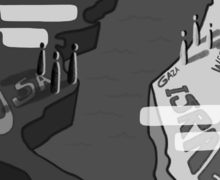Benzinger: What’s in your drinking water? This website finally lets NY residents know for sure.
Victoria Thomas | Contributing Illustrator
New York residents look online see what's in their water supply, but it was hard to find until NYPIRG introduced the What's In My Water? program.
Access to clean water is a basic human right, but it can be tough for average people to know how safe their water really is. A new tool launched by NYPIRG, however, can help to fill the void of government agencies when it comes to informing constituents about water safety.
“What’s in my Water?” allows New York state residents to search the source and quality of their drinking water or view a map of potential threats to drinking water in their area. By making information about water accessible and easy to understand — something the state and federal governments have neglected — the New York Public Interest Research Group is making it easier for people to ensure their right to clean water is being met.
“NYPIRG set out about a year ago to begin this project because we think that access to clean drinking water is not a privilege, and that access to clear information about water shouldn’t be either,” said Megan Ahearn, a program director at NYPIRG.
Government transparency is necessary for active and conscientious citizenship, especially when it comes to environmental issues. And New York state residents are at a disadvantage if they do not have the information required to be active constituents and hold government agencies accountable.

Andy Mendes | Digital Design Editor
“Whether it be industrial business that is affecting public water, or if there is a chemical in a water test that is concerning, the public needs to have proof and information so that they can advocate for themselves,” Ahearn said.
The NYPIRG tool contains data on regulated and unregulated contaminants in water supplies. It also provides context for what that data and various terms used in the report mean, helping ordinary New Yorkers understand what they’re putting into their bodies.
This information is online, so the government technically made it available to the public, said Sharon Moran, a professor of environmental studies at the State University of New York College of Environmental Science and Forestry. But it’s buried, Moran said, “and you need technical expertise to make sense of it.”
In the wake of water crises in Flint, Michigan, and Hoosick Falls, New York, it’s become apparent that residents must stay aware of their water quality so they can readily advocate for themselves. But water quality isn’t the only component. Residents need to be aware of where their water comes from.
After conducting research in June of 2016 about whether New Yorkers know where their water supply originates, Moran found that about 25 percent of state residents have no idea where their water comes from. Another 16 percent think they know but are wrong, Moran said.
Syracuse’s water supply comes from Skaneateles Lake, which is located about 30 minutes from the city. The lake water is considered to be of high enough quality that it does not require filtration, but it is still disinfected and monitored, per the City of Syracuse’s website.

Andy Mendes | Digital Design Editor
According to “What’s in my Water?,” there hasn’t been a violation in Skaneateles Lake since 2009, when coliform levels reached the maximum allowed amount. But that doesn’t mean there isn’t cause for concern.
Since motor boating is allowed on the lake, Moran said that after big holidays like the Fourth of July, an increase in organic residues is observed in the water.
Syracuse residents should remember this lake is where their drinking water comes from and take any preventative measures they think are necessary.
People who have impaired immune systems may consider boiling their water before drinking it if microorganisms are present in their water supply. If lead is present in the water supply, families with young children may want to consider additional filters for their household. “What’s in My Water?” can make these big decisions easier.
“There’s no underscoring how important healthy and clean water is, and the public needs to have information in order to protect themselves,” said Ahearn, the NYPIRG director.
Water quality is only one area that deserves more government transparency. And when groups like NYPIRG help fill the gaps, they give people the power to hold government accountable and make smart decisions for themselves.
Bailey Benzinger is a sophomore magazine journalism major and environment and society minor. Her column appears biweekly. She can be reached at bpbenzin@syr.edu.
Published on June 23, 2017 at 12:45 pm





